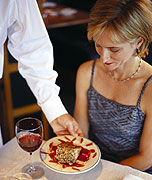
WEDNESDAY, Feb. 8 (HealthDay News) — Ballooning portion sizes have shouldered some of the blame for America’s obesity epidemic. However, a new study suggests that, when asked, many restaurant patrons will readily “downsize” their meal.
When offered the choice, even without a price cut, many customers opted for less food instead of more, the study found.
“We know that restaurant meals have grown in size in the last 20 years, and we had some evidence that many restaurant goers thought that restaurant meals were too large,” said researcher Jason Riis, an assistant professor of business administration at the Harvard Business School in Boston.
“So we had the intuition that if we asked people to take smaller portions, even for no discount, they would be willing to do that, and that’s in fact what we found,” he said.
The smaller portion was offered on a side dish, which is often made larger to give the appearance of value, Riis said.
“It’s very cheap for restaurants to add on a little bit more food. The ingredients are not the bulk of their costs. Super-sizing is an inexpensive way to increase a perception of value,” he explained.
“Many people know they eat too much,” Riis added.
But people, by and large, have no willpower, he noted. “Once food is on our plate, we eat it; by then it’s too late for self-control. We have got to work harder to get the right amount of food on our plates. The customer bears some responsibility for this, but restaurants also bear some responsibility,” Riis said.
Restaurants can cut back portions and people can ask for smaller portions as well. “Don’t be afraid to ask for right size portions,” he suggested.
The report was published in the Feb. 8 online edition of Health Affairs.
For the study, Riis’ team had waiters in a Chinese fast-food restaurant offer customers half portions of rice or noodles, sometimes for less money but other times with no price break.
The investigators found that 14 percent to 33 percent of customers went for the downsizing offer, whether or not they were given a discount of 25 cents.
Most people did not order more food to make up for the smaller portion. On average, smaller portions cut more than 200 calories from the meal, Riis said.
Downsizing also didn’t change how much food was left on the plate, so there were actual calories saved, the researchers noted.
In addition, having calorie counts on the menu didn’t make a difference in customer choices. “If anything, the downsizing offer was less effective in changing customers’ ordering patterns with the calorie-labeling present,” the researchers said.
Samantha Heller, a dietitian, nutritionist, exercise physiologist and clinical nutrition coordinator at the Center for Cancer Care at Griffin Hospital in Derby, Conn., commented that “research suggests that patrons will eat healthy foods more often if they are featured prominently on the menu.”
And, she added, “Eating a few hundred calories less per day can add up to significant weight loss over time. Let’s use the current study to kick off a new restaurant trend; helping people to help themselves by simply featuring healthy foods on menus and asking patrons if they want smaller portions.”
Commenting on the study, Dr. David Katz, director of the Prevention Research Center at Yale School of Medicine, said that “it’s refreshing to see that common sense can be reactivated with a simple nudge — asking people if they might prefer to eat less.
“The question forces a conscious decision to replace what has become almost automatic behavior — and the results look promising. Thinking about food portion before ordering looks to be very good food for thought,” Katz said.
More information
For more on healthy dining, visit the U.S. Department of Agriculture.

